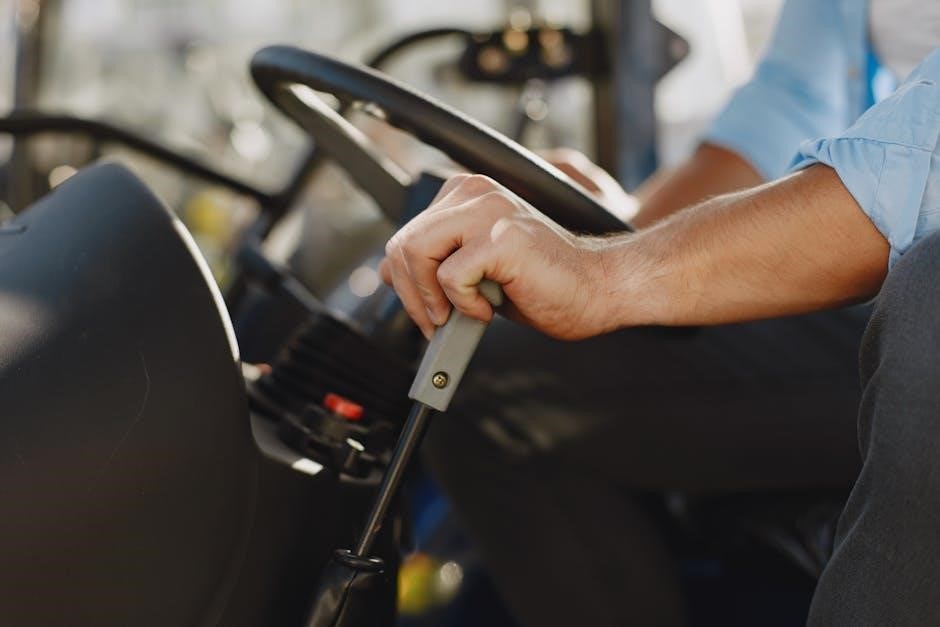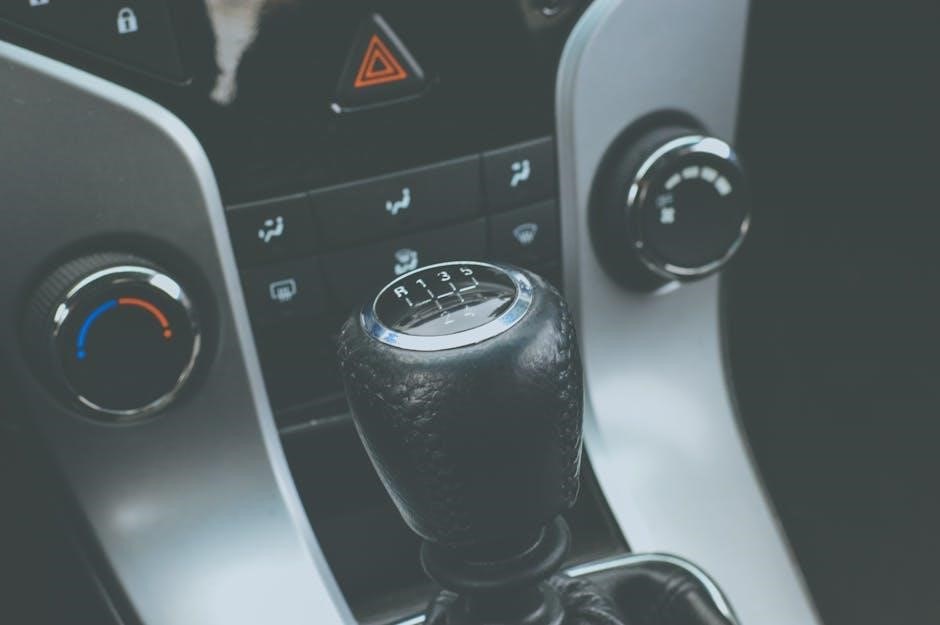Preparation
Before reversing, adjust your seat and mirrors for clear visibility. Fasten your seatbelt and ensure the area around the car is clear of obstacles. Hold the clutch and brake pedals down to maintain control. This preparation ensures a safe and smooth reversing process in a manual transmission car.

Safety Measures
Ensuring safety is paramount when reversing a manual transmission car. Always begin by thoroughly checking your surroundings for pedestrians, other vehicles, and obstacles. Use your rearview and side mirrors to maximize visibility, and consider turning your head to look over your shoulder for a clearer view. Avoid reversing in areas with poor lighting or heavy traffic.
Keep your speed slow and deliberate, as this allows more time to react to unexpected situations. Avoid sudden movements of the steering wheel, as they can lead to loss of control. Use the clutch and brake pedals gently to maintain smooth, gradual movement.
Never reverse with distractions, such as using your phone or engaging in conversations. If you notice something unexpected, stop immediately by pressing the brake pedal. Always be vigilant, as the area around your car can change quickly, especially in busy environments.
Additionally, ensure all passengers are aware of the reversing process and are securely fastened in their seats. If you’re unsure about the clearance or visibility, consider asking someone to guide you or use assistive devices like parking sensors if available.
By following these safety measures, you can minimize risks and reverse your manual transmission car with confidence and control.
Shifting into Reverse
Shifting into reverse in a manual transmission car requires careful attention to the gearshift and clutch operation. Start by fully depressing the clutch pedal with your left foot to disengage the current gear. Then, locate the reverse gear position, which is typically found to the left of neutral. Depending on the car’s design, you may need to push down on the gearshift or pull a collar to engage reverse gear.
Once the clutch is fully pressed, navigate the gearshift into the reverse position. You may feel a slight resistance or a “click” when the gear engages. Some manual transmissions have a reverse lockout mechanism to prevent accidental shifting into reverse, so ensure you follow the manufacturer’s specific procedure to engage it properly.
After successfully shifting into reverse, slowly release the clutch pedal while gently pressing the accelerator with your right foot to begin moving backward. Keep your movements deliberate and controlled to avoid sudden jerks or loss of control. Always remember to check your surroundings thoroughly before and during the reversing process.
Never attempt to shift into reverse while the car is moving forward, as this can cause damage to the transmission. If you need to stop while reversing, press the clutch and brake pedals simultaneously to bring the car to a halt. Engaging the parking brake when stopped is also a good practice for added safety.
Practice shifting into reverse in a safe, open area to build familiarity with the process and ensure smooth operation.
Visibility
Maintaining clear visibility is crucial when reversing a manual transmission car. Always adjust your seat and mirrors to provide an unobstructed view of the rear. Turn your head to look over your right shoulder to see behind the vehicle, as relying solely on mirrors may not provide a complete picture.
Use your rearview and side mirrors to monitor the area around the car, but be aware of blind spots. If equipped, utilize a rearview camera for additional visibility. Keep your eyes moving between the mirrors and the area behind the car to stay alert to any potential hazards.
Ensure the backlight is not obstructed by passengers or objects in the car. If visibility is poor due to weather or darkness, use the car’s lights to illuminate the area. Avoid reversing in a straight line without checking your surroundings periodically.
Keep your window rolled down if necessary to hear any unexpected noises or warnings from pedestrians or other vehicles. Always prioritize slow, deliberate movements to allow time to react to changes in your environment.
Good visibility is key to safe reversing, so take the time to position yourself and adjust your mirrors properly before moving backward. This will help you avoid accidents and maneuver confidently, even in tight spaces.

Reversing
To reverse a manual transmission car, start by fully pressing the clutch pedal down with your left foot. While holding the clutch down, use the gearshift to select reverse gear, which is typically located to the left of neutral. You may need to press a button or move the gearstick in a specific way to engage reverse due to the reverse lockout mechanism.
Slowly release the clutch pedal while gently pressing the accelerator with your right foot to begin moving backward. It’s important to release the clutch smoothly to avoid stalling the car. Keep your eyes on the path behind you, using your rearview and side mirrors to monitor for obstacles.
Turn your head to look over your shoulder for better visibility, especially in blind spots. Avoid sudden movements and maintain a slow, steady speed to ensure control. If you need to stop, press the clutch down and apply the brake gently.
When reversing uphill or in tight spaces, use the brakes and clutch smoothly to maintain balance. Practice in an open area to master the coordination of clutch, accelerator, and steering. Reversing a manual car requires attention and practice to perform safely and effectively.

Stopping
Stopping while reversing a manual transmission car requires careful coordination of the clutch and brake pedals. To come to a stop, press the clutch pedal down with your left foot and shift the gearshift into neutral. Simultaneously, apply gentle pressure to the brake pedal with your right foot to slow the car down smoothly.
When stopping on an incline, use the handbrake to prevent the car from rolling backward. Always avoid sudden stops, as they can cause skidding or loss of control. Instead, slow down gradually by easing off the accelerator and applying the brake progressively.
If you need to stop temporarily while reversing, keep the clutch pedal pressed down and the car in neutral. This ensures the car does not roll or jerk unexpectedly. When you’re ready to move again, release the clutch slowly while pressing the accelerator gently.
Remember to always be aware of your surroundings while stopping, as reversing can limit your visibility. Use your mirrors and look over your shoulder to stay alert for obstacles or pedestrians. Proper stopping technique is crucial for maintaining control and safety while reversing a manual transmission car.

Special Situations
Reversing a manual transmission car in special situations requires extra caution and skill. One common challenge is reversing on an incline. Always use the handbrake to prevent the car from rolling backward. Engage the handbrake fully before shifting into reverse and release it gradually as you begin to move.
If you encounter a tight space while reversing, use the “bite” point of the clutch to creep slowly. This allows precise control over the car’s movement. Avoid sudden jerks, as they can cause loss of control or damage to surrounding objects.
When reversing in low-visibility conditions, such as at night or in heavy rain, rely on your mirrors and external cameras if available. Turn your head frequently to check blind spots and reduce speed to compensate for limited visibility.
In emergencies, such as reversing to avoid an obstacle, stay calm and maintain control. Shift into a lower gear if needed to slow down and use the brakes gently. Avoid sudden shifts or sharp turns, as they can destabilize the car.
Practice reversing in open, obstacle-free areas to build confidence and master these techniques. Special situations highlight the importance of smooth clutch control, precise steering, and constant awareness of your surroundings while reversing a manual transmission car.
General Tips
Mastering how to reverse a manual transmission car requires practice and attention to detail. Always start by checking your mirrors and turning your head to ensure a clear view behind the vehicle. Use the clutch smoothly to avoid jerky movements, and maintain a slow, steady pace to retain control.
When reversing, keep your right foot light on the accelerator and your left foot ready to press the clutch if needed. Avoid distractions, such as using your phone, and focus on the path behind you. If you lose visibility, stop and get out to check the area if necessary.
For straight-line reversing, align the car with a visible reference point and steer straight. To reverse at an angle, turn the steering wheel gradually in the desired direction while monitoring your surroundings. Always use the handbrake if you need to stop temporarily on an incline.
Practice reversing in an open space, such as an empty parking lot, to build confidence and improve your skills. Familiarize yourself with the “bite” point of the clutch to control the car’s speed more effectively. By following these general tips, you can become more comfortable and proficient in reversing a manual transmission car.
Remember, patience and consistent practice are key to mastering reverse driving in a manual car. Over time, these techniques will become second nature, enhancing your overall driving ability and safety on the road.

Troubleshooting
Troubleshooting common issues when reversing a manual transmission car is essential for smooth operation. One frequent problem is difficulty engaging reverse gear, often caused by not fully depressing the clutch or misaligning the gearshift. To resolve this, ensure the clutch is fully pressed and navigate the shift carefully into the reverse position.
A jerky movement when reversing can result from abrupt clutch release or excessive accelerator input. To fix this, practice releasing the clutch slowly and use gentle throttle adjustments. If the car hesitates or stalls, check for proper clutch control and ensure the gear is fully engaged;
Another issue is slow or unresponsive reversing, which may stem from incorrect gear selection or insufficient throttle. Verify that the car is in reverse gear and gradually increase acceleration as needed. If the car struggles to move backward, inspect for any obstructions or mechanical issues.
Additionally, improper alignment when reversing can lead to difficulty maneuvering. Use reference points and mirrors to guide the car and avoid oversteering. If reversing uphill, ensure the handbrake is securely applied to prevent rolling.
Lastly, grinding noises while shifting into reverse may indicate improper clutch use or gear misalignment. Stop immediately, restart the process, and ensure smooth clutch and gear engagement. Addressing these common issues will improve your reversing experience in a manual transmission car.
Practice
Practicing reversing in a manual transmission car is crucial for mastering the skill. Begin by finding a safe, open space like an empty parking lot to minimize obstacles. Start with the basics: press the clutch pedal fully down, shift into reverse gear, and slowly release the clutch while gently pressing the accelerator. Use reference points on the car to guide your path and check your mirrors frequently.
When first starting, keep your speed low to maintain control and visibility. Look over your shoulder to see behind the car, as relying solely on mirrors may not provide a complete view. Turning your head allows for better spatial awareness and helps in aligning the car correctly.
Steering while reversing requires careful attention. Turn the wheel in the direction you want the rear of the car to go. For example, to reverse to the right, turn the wheel to the right. Practice reversing in straight lines and at angles to build your skills. If the car stalls, remain calm, press the clutch down, shift to neutral, and restart the engine before continuing.
Another important aspect is feathering the clutch—slowly releasing it while applying gentle pressure to the accelerator. This helps prevent jerky movements and maintains smooth control. Avoid riding the clutch, as this can wear out the clutch over time. Instead, keep the pedal fully pressed or fully released.
As you gain confidence, incorporate turning while reversing. This involves steering in the desired direction while slowly moving backward. Always be aware of your surroundings and use your mirrors and looking over your shoulder to stay informed about your environment.
Reversing uphill or on an incline requires additional caution. Ensure the parking brake is engaged to prevent rolling and use the clutch and accelerator smoothly to maintain control. If equipped, use features like a rearview camera to enhance visibility and reduce blind spots.
Finally, practice reversing in different conditions, such as on slopes or in tight spaces, to become proficient in various scenarios. Consistent practice will help you become comfortable and confident when reversing a manual transmission car. Remember, patience and persistence are key to mastering this essential driving skill.
Parking
Parking a manual transmission car in reverse requires precision and careful maneuvering. Whether parallel parking or backing into a space, alignment and control are key. Start by positioning the car at the correct angle relative to the parking space. For parallel parking, align your car with the vehicle in front of the space and reverse slowly, turning the steering wheel sharply in the direction of the space.
Use your mirrors and look over your shoulder to gauge your position. Reference points on the car, such as the rear bumper and side mirrors, can help guide you into the space. Straight parking involves reversing into a space between two cars, requiring careful alignment and slow, steady movement.
For angled parking, turn the wheels in the direction of the space as you reverse. Use the side mirrors to monitor your distance from the lines or nearby vehicles. Always maintain a slow speed to avoid mistakes and allow time to make adjustments.
If the space is tight, consider using a reference point on the dashboard to align with the parking lines. Feather the clutch and brake to control the car’s speed precisely. Practice in different types of parking spaces to build confidence and accuracy.
Remember, parking in reverse with a manual transmission requires smooth coordination of the clutch, accelerator, and steering wheel. Take your time and focus on clear visibility and precise movements to ensure safe and successful parking.



